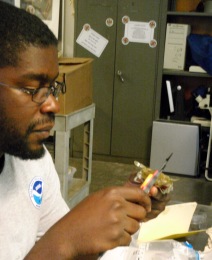New, environmentally-friendly technology has potential to protect oyster larvae from pathogens and increase hatchery yields
Shellfish pathogens have long been a major challenge for oyster hatcheries in the Chesapeake Bay region. Mortality rates are high for larval oysters, most of which do not survive the transition from free-swimming larvae to anchored tiny versions of adults, called spat. While the yield might be around 40% for larval oysters in the cooler months, in the summer, when pathogenic bacteria is prevalent, the yield is reduced to about 20%. How can hatcheries prevent disease and increase their yields without resorting to antibiotics, which can unintentionally promote antibiotic-resistant pathogen strains?

NOAA scientists from the Northeast Fisheries Science Center in Milford, CT, in collaboration with a NOAA Educational Partnership Program (EPP)-funded graduate student, Ammar Hanif, Dr. Eric Schott and Dr. Hal Schreier, all part of the NOAA Living Marine Resources Cooperative Science Center, have discovered a promising solution. Oyster hatcheries may soon be able to employ probiotics as a proactive and environmentally-friendly method to increase their yields. Probiotics are microorganisms that confer health benefits, such as the beneficial bacteria found in yogurt which aid digestion.
Hanif and Schott, along with NOAA researchers Dr. Gary Wikfors and Diane Kapareiko, first published a paper in 2011, which described their preliminary investigation of the efficacy and safety of using naturally-occurring probiotic bacteria isolated from the gut of eastern oysters and bay scallops (Lim et al 2011). They tested 26 bacterial candidates and found that 16 of those candidates were able to inhibit known shellfish pathogens in the lab. None of the strains negatively impacted the larvae. Ammar Hanif characterized the bacterial isolates by culturing them in the lab and sequencing three genes.
The team then conducted pilot-scale trials with the most promising probiotic candidate, known as OY15 (Kapareiko et al 2011). The results indicated that OY15 significantly improved survival when oyster larvae inoculated with it were exposed to a pathogen. This study also led to a full genome sequence of both OY15 (Schreier & Schott 2014b) and a prominent oyster pathogen (Schreier & Schott 2014a), conducted with the assistance of EPP-funded undergraduate students in the lab of Dr. Schreier. The Schreier lab is also examining the interaction of the probiotic with the pathogen on a molecular level. This year, researchers at the University of Rhode Island are conducting field trials with OY15. If field trials agree with the pilot scale results, oyster probiotics could be available on the market in 2-3 years.
Ammar Hanif, an EPP-funded graduate student at the University of Maryland Center for Environmental Science (UMCES) Institute of Marine and Environmental Technology (IMET), says the coolest thing about being part of the project is that the results have fueled an ongoing collaboration between UMCES IMET and the Northeast Fisheries Science Center and could have a significant impact on the oyster fishery. For an additional three years, IMET faculty, including Dr. Schreier, received added support to train students and conduct experiments with the Northeast Fisheries Science Center at the oyster hatchery in Milford each summer.
Hanif’s career goals include working at NOAA as a molecular fisheries ecologist and developing innovative solutions to fisheries challenges so that we may enjoy the many benefits of our marine resources for generations to come.
Hanif completed his M.S. in fall 2012 under the supervision of Dr. Eric Schott, and is now pursuing a Ph.D. at UMCES IMET. His current project employs molecular techniques to study the diet and feeding of menhaden, a primary forage fish and food source for commercial species in the Chesapeake. He recently received a graduate research fellowship from Maryland Sea Grant. Hanif’s career goals include working at NOAA as a molecular fisheries ecologist and developing innovative solutions to fisheries challenges so that we may enjoy the many benefits of our marine resources for generations to come.
The objective of the NOAA Educational Partnership Program (EPP) with Minority Serving Institutions (MSI) is to increase opportunities for students to pursue applied research and graduate in fields directly supporting NOAA's mission. EPP supports NOAA’s goal of building a highly skilled and diverse next generation STEM workforce. The Cooperative Science Centers are a key component of the EPP, as they promote collaborative research with NOAA and capacity building in NOAA-mission sciences at MSI universities. UMCES IMET is part of the NOAA Living Marine Resources Cooperative Science Center, which supported the collaboration between Hanif, Schott, Schreier and NOAA researchers at the Northeast Fisheries Science Center. This is just one example of the productive and economically relevant research supported by the NOAA Cooperative Science Centers, which has resulted in over 1,200 peer-reviewed publications to date.
References:
Lim, H. J., D. Kapareiko, E.J. Schott, A. Hanif & G. H. Wikfors. 2011. Isolation and evaluation of new, probiotic bacteria for use in shellfish hatcheries: I. Isolation and screening for bioactivity. J. Shellfish Res. 30, 609– 615.
Kapareiko, D., Lim, H. J., Schott, E. J., Hanif, A. and G. H. Wikfors. 2011. Isolation and Evaluation of New Probiotic Bacteria for use in Shellfish Hatcheries: II. Effects of a Vibrio sp. Probiotic Candidate Upon Survival of Oyster Larvae(Crassostrea virginica) in Pilot-Scale Trials. J. Shellfish Res. 30, 617-625.
Schreier H.J., Schott E.J. 2014a. Draft genome sequence of the shellfish bacterial pathogen Vibrio sp. strain. B183. Genome Announcements 2(5): e00914-14.
Schreier H.J., Schott E. J. 2014b. Draft genome sequence of oyster larval probiotic bacterium Vibrio sp. Strain OY15. Genome Announcements 2(5): e01006-14.



